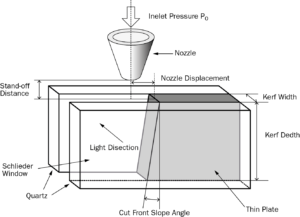 Gas lasers are highly suitable for working non-metal materials and the majority of plastics. They have a relatively high efficiency and excellent beam quality. Therefore, they are the most diffused laser type. Nevertheless, the gas behaviour does not determine only the thermal oxidation power but it influences also the removal of the melt metal during the gas laser cutting. The separation of the flow inside the cut is the main problem for the deterioration of the cutting capacity and quality, in particular concerning the cutting of steel sections of big thickness because it significantly weakens the cutting stress on the melt slag and changes the pressure gradient along the cutting front. Some researches have been carried out on the flow separation, using the numerical simulation and the cutting model. However, many experimental details and the results are not clear and the numerical simulation is disputable owing to the absence of experimental verification. In this document, a cutting model is set according to the results attained by previous observation and cutting studies. High resolution and high speed of Schlieren visualization is used to observe the formation of flow separation in the cutting model. Stand-off distance, input pressure, displacement of nozzles, cutting width and nozzle inclination angle have been used as variables for the Schlieren visualization. The effect of parameters on the position and the flow separation model have been discussed according to the dynamic gas theory. They assessed that the nozzle displacement, the cutting width and the nozzle inclination angle are the key factors for the flow separation. The possible strategies for the flow separation control have been proposed for both subsonic and supersonic nozzles.
Gas lasers are highly suitable for working non-metal materials and the majority of plastics. They have a relatively high efficiency and excellent beam quality. Therefore, they are the most diffused laser type. Nevertheless, the gas behaviour does not determine only the thermal oxidation power but it influences also the removal of the melt metal during the gas laser cutting. The separation of the flow inside the cut is the main problem for the deterioration of the cutting capacity and quality, in particular concerning the cutting of steel sections of big thickness because it significantly weakens the cutting stress on the melt slag and changes the pressure gradient along the cutting front. Some researches have been carried out on the flow separation, using the numerical simulation and the cutting model. However, many experimental details and the results are not clear and the numerical simulation is disputable owing to the absence of experimental verification. In this document, a cutting model is set according to the results attained by previous observation and cutting studies. High resolution and high speed of Schlieren visualization is used to observe the formation of flow separation in the cutting model. Stand-off distance, input pressure, displacement of nozzles, cutting width and nozzle inclination angle have been used as variables for the Schlieren visualization. The effect of parameters on the position and the flow separation model have been discussed according to the dynamic gas theory. They assessed that the nozzle displacement, the cutting width and the nozzle inclination angle are the key factors for the flow separation. The possible strategies for the flow separation control have been proposed for both subsonic and supersonic nozzles.
Source: Chi Zhang, Peng Wen, Zhaohui Yao, Yueming Yuanand Xuejun Fan, «Visualization of flow separation inside cut kerf during laser cutting of thick sections», J. Laser Appl. 28, (2016). DOI: http://dx.doi.org/10.2351/1.4943997



